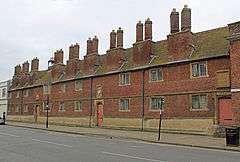Gray's Almshouses
| Gray's Almshouses | |
|---|---|
 Gray's Almshouses | |
 Location within Somerset | |
| General information | |
| Architectural style | Jacobean |
| Town or city | Taunton |
| Country | England |
| Coordinates | 51°00′53″N 3°05′53″W / 51.01475°N 3.09801°WCoordinates: 51°00′53″N 3°05′53″W / 51.01475°N 3.09801°W |
| Construction started | 1635 |
| Completed | 1696 |
Gray's Almshouses is a terrace of almshouses in Taunton, Somerset, England. Founded by Robert Gray in 1635, the building is among the oldest remaining in Taunton, and one of the earliest brick buildings in the county. The terrace contained accommodation for six men, ten women and a reader, who acted as a chaplain and schoolmaster. The building is designated as a Grade I listed building by English Heritage, and after renovation in the late twentieth century it currently provides nine flats for the elderly.
History
Robert Gray was born in Taunton in 1570,[1] but made his fortune in London, where he became a citizen and Merchant Taylor. He owned a shop in Bread Street in London, in which he traded in cloths he purchased from provincial fairs then finished and dyed. His business was successful enough to allow him to build almshouses in his town of birth in 1635.[2] The initial building which Gray had built for the parish of Taunton St Mary Magdalene housed apartments for ten poor women, a chapel and a schoolroom, as well as a room for a reader, who acted as a chaplain and schoolmaster. The reader was obliged to teach ten poor children from the parish to read and write. A further building to house six poor men was delayed by Gray's death in 1638, though he left instructions for the Merchant Taylors to complete it in his will. In addition to building the almshouses, Gray also gave £2,000 in fee simple land, the profits of which were paid to the poor, with each receiving eight shillings a month.[n 1][4] Further donations in the eighteenth century by John Noble and John Coles resulted in the allowance for the poor, which was by that time paid weekly, to be increased from two to three shillings. The English Civil War and legal issues delayed the completion of this additional section until 1696.[5]
The almshouses were built on East Street in Taunton, next to the house where Gray had been born.[6] The brick construction of the almshouses protected them during the Civil War; the adjoining wooden Pope's almshouses were burnt down by the Royalist troops during the Siege of Taunton.[5]
Architecture
In his 1822 history of Taunton, Joshua Toulmin described Gray's almshouses as the largest in Taunton, being 130 feet (40 m) in length.[4] The building is of two-storeys, with similar mullioned windows on each level and three entrances. Above two of the entrances are coats of arms: those of Robert Gray, and of the Merchant Taylors.[7] There are nine chimney stacks, each with two chimneys set diagonally. The building is of red brick, the brickwork being the same on the newer and older sections which are separated by a straight joint. The almshouses are among the oldest surviving brick buildings in Somerset,[8] and the Somerset Archaeological and Natural History Society suggest that it is unlikely there are any older.[9] The roof is of clay tiles.[5][8] Brian Bailey describes the buildings as conforming to an "austere Jacobean style", with the pair of crests over the doors being the "only departure here from unadorned severity of style."[10]
Current usage

The building was designated as a grade I listed building by the English Heritage on 4 June 1952,[7] categorising it as a building "of exceptional interest".[11] The Taunton Heritage Trust took control of Gray's Almshouses in the 1960s, and in 1989 they conducted a complete refurbishment of the property with the help of grants from the Tenant Services Authority and English Heritage. The building currently contains nine flats providing sheltered housing for pensioners, along with a laundry room and a communal room. A competition was held in 2004 for students at Somerset College of Arts and Technology studying interior design to suggest improvements to the décor and lighting that would help to brighten the flats; various changes were made as a result of the competition.[5]
See also
Notes
- ↑ According to The National Archives' currency converter, £2,000 in 1630 would be the equivalent of £178,320 in 2005, while that amount in 1640 would be the equivalent of £171,600 in 2005.[3]
References
- ↑ Barrett, C. R. B. (1894). Somersetshire: highways, byways, and waterways. London: Bliss, Sands & Foster. p. 296.
- ↑ Sheppard, Francis (1998). London: A History. Oxford: Oxford University Press. p. 1. ISBN 978-0-19-822922-3.
- ↑ "Currency converter". The National Archives. Retrieved 16 June 2013.
- 1 2 Toulmin, Joshua (1822). The history of Taunton, in the county of Somerset. London: John Poole. pp. 213–8.
- 1 2 3 4 "History". Taunton Heritage Trust. Retrieved 13 June 2013.
- ↑ Nightingale, Rev. J. (1813). The Beauties of England and Wales: Or Delineations, Topographical, Historical and Descriptive of Each County. XIII. London: Printed for J. Harris; Longman and Co. (and 10 others). p. 541.
- 1 2 "List entry: Gray's Alsmhouses". English Heritage. Retrieved 15 June 2013.
- 1 2 Pevsner, Nikolaus (1958). The buildings of England: South and West Somerset. London: Penguin Books. pp. 63, 317. ISBN 9780300096446.
- ↑ Somerset Archaeology and Natural History: The Proceedings of the Somersetshire Archaeological and Natural History Society, Volumes 135-136. The Society. 1991. p. 131.
- ↑ Bailey, Brian (1988). Almshouses. Hale. p. 115. ISBN 978-0709032922.
- ↑ "Principles of Selection for Listing Buildings" (PDF). Department for Culture, Media and Sport. March 2010. p. 4. Retrieved 16 June 2013.